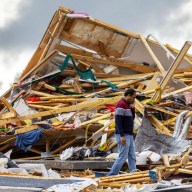MANOKWARI, Indonesia – A string of powerful earthquakes killed at least four people and injured dozens in remote eastern Indonesia on Sunday and briefly triggered fears of another tsunami in a country still recovering from 2004’s deadly waves.
One of the quakes – a 7.3-magnitude tremor – was felt as far away as Australia and sent small tsunamis into Japan’s southeastern coast.
Residents near the epicentre in Papua province rushed from their homes in search of higher ground shortly after the first, 7.6-magnitude quake struck at 4:43 a.m. local time, afraid that huge waves might wash over the island.
The epicentre was about 135 kilometres from Papua’s main city of Manokwari and occurred at a depth of 35 kilometres, the U.S. Geological Survey said. It was followed by dozens of aftershocks.
At least four people died, dozens were injured and some 135 homes and other buildings were badly damaged or toppled in the province. Power lines fell, cutting electricity, and the runway at Manokwari’s Rendani airport was cracked, prompting cancellation of commercial flights.
The government initially issued a tsunami warning but lifted it within an hour after it was confirmed that the epicentre was on land, not water.
Quakes centred onshore pose little tsunami threat to Indonesia itself, but those close to the coast can churn up large waves that sometimes reach the coastlines of other countries such as Japan.
Japan reported tsunamis between 10 centimetres and 40 centimetres high hitting its shores following the tremors.
A huge quake off western Indonesia caused the 2004 Indian Ocean tsunami that killed about 230,000 people, more than half of them on the western Indonesian island of Sumatra. Four years on, the multibillion-dollar rebuilding process is almost complete.
Residents in Papua’s Manokwari – a jumble of low-lying brick and cement structures home to 167,000 people – remained jittery late Sunday, with thousands prepared to sleep outside for fear of aftershocks.
“We don’t feel safe,” said Simon, 32, who was staying outside with his wife and three children. “It’s just in case there are strong aftershocks.”
Local officials drove through the streets warning people not to return to structures that might be vulnerable if an aftershock hit.
The Indonesian Healthy Ministry was sending an aid team to Manokwari Sunday night as well as four tonnes of medical supplies and baby food, spokeswoman Lily Sulistyowati said.
Relief agency World Vision Indonesia was flying in 2,000 emergency provision kits, including canned food, blankets and basic medical supplies, said spokeswoman Katarina Hardono. She said its team will try to reach Manokwari by plane, but if needed will make a 36-hour trip by boat.
The National Disaster Co-ordination Agency said 135 houses and buildings were badly damaged or collapsed.
Hengky Tewu, director of a local hospital, said 19 patients were being treated there for broken bones, cuts, crushed fingers and other injuries.
Twenty quake patients were being treated at a navy hospital, said Ina, a nurse who, like many Indonesians, goes by a single name.
Papua, about 2,955 kilometres east of the capital Jakarta, is among the country’s least developed areas, and a low-level insurgency has simmered in the resource-rich region for years. It is off limits to foreign reporters.
Indonesia straddles a chain of fault lines and volcanoes known as the Pacific “Ring of Fire” and is prone to seismic activity.
Sunday’s quake was felt 1,300 kilometres southwest of Papua in Australia’s northern city of Darwin, but no damage was reported there.
















